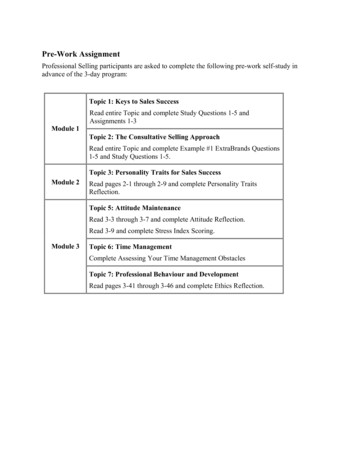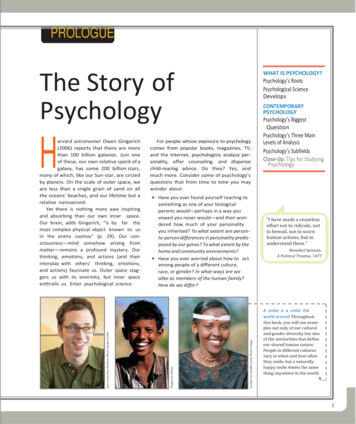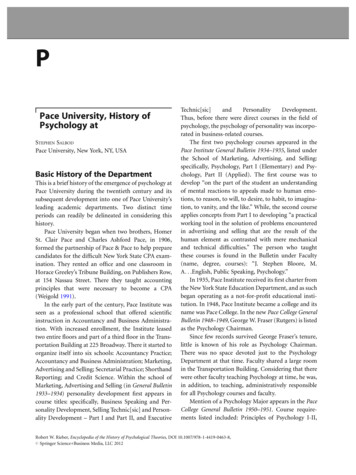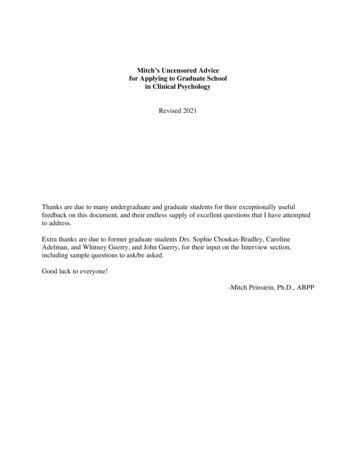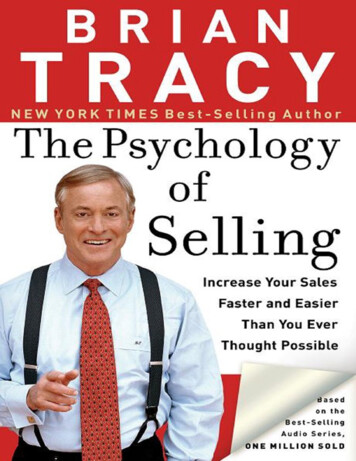
Transcription
The PsychologyofSelling
2004 by Brian TracyAll rights reserved. No portion of this book may be reproduced, stored in a retrieval system, or transmittedin any form or by any means—electronic, mechanical, photocopy, recording, scanning, or other—except forbrief quotations in critical reviews or articles, without the prior written permission of the publisher.Published in Nashville, Tennessee, by Thomas Nelson. Thomas Nelson is a registered trademark of ThomasNelson, Inc.Thomas Nelson, Inc., titles may be purchased in bulk for educational, business, fund-raising, or salespromotional use. For information, please e-mail SpecialMarkets@ThomasNelson.com.Library of Congress Cataloging-in-Publication Data Tracy, Brian.The psychology of selling : how to sell more, easier, and faster than you ever thought possible / by BrianTracy.p. cm.ISBN 978-0-7852-1200-3 (hardcover)ISBN 978-0-7852-8806-0 (trade paper)ISBN 978-0-7852-7910-5 (ie)1. Selling—Psychological aspects. 2. Selling—Handbooks, manuals, etc. I. Title.HF5438.8.P75T73 2004658.86'01'9—dc222004026834Printed in the United States of America 09 10 11 12 13 QW 18 17 16 15 14
This book is dedicated to my friends, colleagues, students, andpractitioners of the great art of selling, to those men and womenwho “bravely go where no one has gone before” to make the salesupon which our companies and nations depend. You are the trueheroes and heroines of our competitive enterprise system.
CONTENTSIntroduction1. The Inner Game of Selling2. Set and Achieve All Your Sales Goals3. Why People Buy4. Creative Selling5. Getting More Appointments6. The Power of Suggestion7. Making the Sale8. 10 Keys to Success in SellingFocal Point Advanced Coaching and Mentoring ProgramAbout the Author
INTRODUCTIONThe imagination is literally the workshop wherein arefashioned all plans created by man.—NAPOLEON HILLThe purpose of this book is to give you a series of ideas, strategies, andtechniques that you can use immediately to make more sales, faster and moreeasily than ever before. In the pages ahead, you will learn to get more out ofyourself, and out of your selling career, than you may have ever thoughtpossible. You will learn how to double, triple, even quadruple your sales andyour income within a few months, or as little as a few weeks.This book is the written version of my internationally successful ThePsychology of Selling audio sales program. Since this program was originallyproduced, it has been translated into sixteen languages and is used in twenty-fourcountries. It is the best-selling professional sales training program in history.Become a Millionaire!According to follow-up research on graduates of the audio program, moresalespeople have become millionaires by listening to and applying these ideasthan by any other sales training process ever developed. Using this material, Ihave personally trained more than five hundred thousand salespeople worldwide,from thousands of companies and from virtually every industry. It really works!My Own StoryI did not graduate from high school. Instead, as a young man, I went off to seethe world. I worked at manual-labor-type jobs for a few years until I had enoughmoney to begin traveling. I worked my way, on a Norwegian freighter, across
the North Atlantic, and then traveled by bicycle, bus, truck, and train aroundEurope, across Africa, and eventually to the Far East. I never missed a meal, butI did postpone a lot of them indefinitely.When I could no longer find a manual-labor job, in desperation, I got intosales. It seems that most of the decisions we make in life are similar to backingup in the night and hitting something, and then getting out to see what it was. Inthis case, for me, it was a sales job.It seems that most of the decisions we make in life are similar to backing up in the night andhitting something, and then getting out to see what it was.Basic TrainingI was hired on straight commission and got the three-part sales trainingprogram: “Here’s your cards; here’s your brochures; there’s the door!” Armedwith this “training,” I began my sales career cold-calling, knocking on officedoors during the day and knocking on residential doors in the evenings.The person who hired me couldn’t sell. But he told me that sales is a“numbers game.” He said that all I had to do was talk to enough people, andeventually I would find someone who would buy. We call this the “mud againstthe wall” method of selling. (If you throw enough mud against the wall,somewhere, somehow, some of it will stick.) This wasn’t much, but it was all Ihad.Then someone told me that sales was really not a “numbers game.” Rather, itwas a “rejection game.” The more rejections you collect, the more sales you arelikely to get. Equipped with this advice, I ran from place to place so I could getrejected more often. They said that I had the “gift of gab,” so I used it. When aperson seemed uninterested, I would speak louder and faster. But even though Ihurried from prospect to prospect, and spoke louder and faster to each person, Iwas barely holding on by my fingernails.The Turning PointAfter six months of struggling, making just enough sales to pay for my singleroom in a small guesthouse, I finally did something that changed my life: I went
room in a small guesthouse, I finally did something that changed my life: I wentto the most successful guy in our company and asked him what he was doingdifferently from me.I wasn’t afraid of hard work. I would get up at five or six in the morning,prepare for the day, and be waiting in the parking lot at 7:00 AM when my firstprospects came to work. I worked all day long, going from office to office andcompany to company. In the evenings, I would knock on residential doors untilnine or ten at night. If the light was on, I would make the call.The top salesman in my office, who was only a couple of years older than me,had a completely different approach. He would roll into the office about nineo’clock. A few minutes later, a prospect would come in, and they’d sit and talk.After a few minutes’ conversation, the prospect would take out his checkbookand write a check for our product.The salesman would then go out that morning and make another couple ofsales, and then have lunch with another prospect. In the afternoon he wouldmake another couple of sales and then perhaps have a drink or dinner withanother prospect. He was selling five and ten times as much as me, or anyoneelse in our office, and he hardly seemed to be working at all.Training Makes the DifferenceIt turned out that he had worked for a Fortune 500 company when he wasyounger. That company had spent sixteen months training him intensively in theprocess of professional selling. With those skills he could then go to work forany company or industry and sell any product or service in virtually any market.Because he knew how to sell, he could sell circles around people like me, eventhough he was working half the time or less. This discovery changed my life.When I asked him what he was doing differently, he said, “Well, show meyour sales presentation, and I’ll critique it for you.”That was my first problem. I had no idea what a “sales presentation” lookedlike. I had heard that there was such a thing, but I had never seen one myself.I said, “You show me yours, and I’ll show you mine.”He was patient and polite. He said, “OK, here is a basic sales presentationfrom beginning to end.” He then walked me, step-by-step, through a sales
from beginning to end.” He then walked me, step-by-step, through a salespresentation for our product.Instead of using a “speech” or clever one-liners to get attention or toovercome resistance, he asked a series of logical questions, from general tospecific, that were ideally suited to a genuine prospect. At the end of this seriesof questions, it had become perfectly clear to the prospect that he could use andbenefit from our product. The final question was simply to close the sale.Take Action ImmediatelyI wrote everything down. Fortified with this new approach to selling, I wentout and started calling on prospects once more. But this time, instead of talking,I asked questions. Rather than trying to overwhelm the prospect with the featuresand benefits of my product, I focused on learning about the prospect’s situationand how I could best help him or her. With this new method, my sales went up.Then I learned about books on selling. I had no idea that some of the bestsalespeople in the world had written some of the best ideas on selling in books. Ibegan reading everything I could find on selling, spending the first two hours ofevery day studying and taking notes.Next I learned about audio learning. It changed my life. I began to listen, hourafter hour, to audio programs as I walked from office to office. I listened to themin the morning; I listened to them in the evening. I rehearsed and practiced thebest sentences and phrases from the best salespeople until I could recite them inmy sleep. And my sales went up and up.Then I discovered sales seminars. I thought I had died and gone to heaven. Ihad no idea how much you could learn from a sales seminar. I began to takeevery seminar and course I could find, even if I had to travel long distances,which I did, and which I could eventually afford to do. And my sales continuedto increase.Moving into ManagementMy sales were so high that my company made me a sales manager. They said,“Whatever you’re smoking, find some people who want to get into sales andshare it with them.”
share it with them.”I began to recruit salespeople off the street and through newspaper ads. Ishowed them my methodology and process of selling. They walked out the doorand began making sales immediately. Today, many of them are millionaires andmultimillionaires.Be the BestThe simple idea that changed my life was the discovery of the “Law of Causeand Effect.” What this law says is that there is a cause for every effect, thateverything happens for a reason. Success is not an accident. Failure is not anaccident either. In fact, success is predictable. It leaves tracks.Success is not an accident. Failure is not an accident either. In fact, success is predictable. Itleaves tracks.Here is a great rule: “If you do what other successful people do, over and overagain, nothing in the world can stop you from eventually getting the same resultsthat they do. And if you don’t, nothing can help you.”Remember that everyone in the top 10 percent in sales today started in thebottom 10 percent. All who are now doing well were once doing poorly.Everyone at the front of the line of life started at the back of the line. And inevery case, what these top people did was learn from the experts. Theydiscovered what other top people were doing to be successful, and they did thesame things themselves, again and again, until they got the same results. And socan you.Use What You LearnSometimes I ask my sales audiences, “What is the most popular piece of homeexercise equipment in America?” After a little hesitation, I tell them: it’s thetreadmill. Americans spend more than one billion dollars on treadmills everysingle year.Then I ask a second question: “If you buy a treadmill and take it home, whatwill determine how much benefit you get from that treadmill?”They answer, “The benefit you get will depend on how often you use it and
They answer, “The benefit you get will depend on how often you use it andhow long you use it each time.”Here’s my point. There is no question about whether or not the treadmill willgive you the results you seek. That has already been established. Everyoneknows that if you use a treadmill regularly and for an extended period of time,you will get definite health benefits.The strategies and techniques you will learn in this book are very much like atreadmill. There is no question about whether or not they work. They are used byall the highest-paid salespeople in every industry worldwide. They are tested andproven. The more you use these methods, the better you will get at them and thebetter and faster results you will achieve. By practicing what you learn in thepages ahead, you will move into the top 10 percent of sales professionals in yourfield and become one of the highest-paid people in the world.Is this a good goal for us to achieve together? If you feel it is, let’s get started.Whatever the mind of man can conceive and believe, it can achieve.—NAPOLEON HILL
1THE INNERGAME OF SELLINGVisualize this thing that you want. See it, feel it, believe in it.Make your mental blueprint, and begin to build.—ROBERT COLLIERNothing happens until a sale takes place. Salespeople are some of the mostimportant people in our society. Without sales, our entire society would come toa grinding halt.The only real creators of wealth in our society are businesses. Businessesproduce all products and services. Businesses create all profits and wealth.Businesses pay all salaries and benefits. The health of the business community inany city, state, or nation is the key determinant of the quality of life and standardof living of the people in that geographical area.
You Are ImportantSalespeople are the most vital people in any business. Without sales, the biggestand most sophisticated companies shut down. Sales are the spark plug in theengine of free enterprise. There is a direct relationship between the success ofthe sales community and the success of the entire country. The more vibrant thelevel of sales, the more successful and profitable is that industry or area.Salespeople pay for all the schools, hospitals, private and public charities,libraries, parks, and all good things that are vital to our standard of living.Salespeople—through their sales and the profits and taxes created by successfulcompanies—pay for government at all levels, for all welfare, unemploymentinsurance, social security, Medicare, and other benefits. Salespeople are essentialto our way of life.Salespeople Are the Movers and ShakersPresident Calvin Coolidge once said, “The business of America is business.”If you strip down the major newspapers, like the Wall Street Journal andInvestor’s Business Daily, and the major business magazines, such as Forbes,Fortune, Business Week, Inc., Business 2.0, Wired, and Fast Company, almosteverything they write about has something to do with sales. All of our financialmarkets, including the prices of stocks, bonds, and commodities, as well ascurrent interest rates, have to do with sales. As a professional salesperson, youare a “mover and shaker” in our society. The only question is, how well do yousell?For many years, sales was considered to be a second-rate occupation. Manypeople were embarrassed to tell others that they were in sales. There was ageneral bias against salespeople. Recently, the president of a Fortune 500company told a journalist, “Around here, we consider sales to be the sleazy sideof our business.”
The Best CompaniesThis attitude is changing quickly. Today, the very best companies have thevery best salespeople. The second-best companies have the second-bestsalespeople. The third-best companies are on their way out of business. The mostsuccessful organizations in the world are all superb selling organizations.Hundreds of universities now offer courses in professional selling, a greatchange from a few years ago. Many young people are coming out of college andimmediately seeking positions in sales with large companies. More CEOs ofFortune 500 companies have come up through the ranks from sales than fromany other part of the company.More CEOs of Fortune 500 companies have come up through the ranks from sales thanfrom any other part of the company.The most powerful businesswoman in America today is Carly Fiorena, presidentand CEO of Hewlett Packard. After obtaining a degree in medieval history fromStanford, she went to work at AT&T in sales and worked her way up. PatMulcahy, the president of Xerox, also worked her way up from sales. Many ofthe top companies in the world are headed by former salespeople.
High Income and Job SecurityYou can be proud to be a sales professional. Your ability to sell can give you ahigh income and lifelong job security. No matter how many changes take placein the economy, there will always be a need for top salespeople. Regardless ofhow many companies and industries become obsolete or just go out of business,good salespeople will always be in high demand. By becoming excellent insales, you can accomplish any financial goal you set for yourself.Seventy-four percent of self-made millionaires in America are entrepreneurs,people who start and build their own businesses. They get an idea for a productor service that no one else is offering, or which they feel they can offer betterthan the competition, and they start their own businesses. And amongentrepreneurs, the single most important skill for success is the ability to sell.Every other skill can be hired away from someone else. But the ability to sell isthe key factor determining a company’s success or failure.Five percent of self-made millionaires in America are salespeople who haveworked for other companies all their lives. Salespeople today are some of thehighest-paid people in America, often earning more than doctors, lawyers,architects, and persons with extensive academic degrees.Sales is a gainful profession. In sales, there is no ceiling on your income. Ifyou are properly trained, are skilled, and are selling the right product in the rightmarket, there is no limit to the amount of money you can make. Selling is theonly field in our society where you can start with little skill or training, comefrom any background, and be making a great living in a matter of three to twelvemonths.The 80/20 Rule in SellingWhen I started selling, someone told me about the Pareto principle, also knownas the 80/20 rule. He said, “The top 20 percent of salespeople make 80 percentof the money, and the bottom 80 percent only make 20 percent of the money.”Wow! I was young, and this was a real eye-opener for me. I made a decision,right then, that I was going to be in the top 20 percent. Later I learned that thiswas one of the most momentous decisions and turning points of my life.
was one of the most momentous decisions and turning points of my life.Again, the top 20 percent of salespeople make 80 percent of the sales and 80percent of the money. The bottom 80 percent of salespeople only make 20percent. Your mission is to decide to join the top 20 percent, and then to learnhow to get there.The Pareto principle also applies to the top 20 percent of salespeople. It saysthat the top 20 percent of the top 20 percent, which equals the top 4 percent, earn80 percent of the money in the top 20 percent of salespeople. Wow! In everylarge sales force, four or five people out of one hundred make as many sales andearn as much money as all the rest put together.
Never Worry About MoneyThere is a very good reason to get into the top 20 percent, and then later, intothe top 4 percent: you will never have to worry about money again or fret aboutjob security. You’ll never lose sleep over employment. The people in the top 20percent or better are some of the happiest people in our society.On the other hand, the people in the bottom 80 percent are worried aboutmoney. One of the great tragedies of our society, the most affluent in humanhistory, is that the majority of people worry about money most of the time. Theyget up in the morning thinking about their money problems. They think abouthow little money they have all day long. When they come home at night, theytalk and often argue about money and how much everything costs. This is not agood way to live.
Top People Earn Vastly MoreThe people in the top 20 percent, on average, earn sixteen times the averageincome of the people in the bottom 80 percent. Those in the top 4 percent earnon average sixteen times that of the folks in the bottom 20 percent. This isastonishing!A large American insurance company tested this 80/20 rule some years agowith their several thousand agents nationwide. They discovered that they hadindividual agents throughout the country who alone were selling and earningmore than twenty to thirty other full-time, trained, professional agents, eventhough they were all selling the same products to the same people, at the sameprices out of the same offices, under the same competitive conditions.In the same year, I addressed two elite groups in two different industries. Thepeople in these industries had all started off on the street, dialing for dollars outof the newspaper or the Yellow Pages. They all worked on straight commission,one sale at a time. But the average yearly income of the salespeople in these elitegroups was 833,000 and 850,000. Some of the top people in these groupsearned several million dollars a year on straight commission!Your goal must therefore be to get into the top 20 percent, and then the top 10percent, the top 5 percent, the top 4 percent, and so on. The purpose of this bookis to get you there. It is to take you from wherever you are today to wherever youwant to go in the future. It is to make you one of the highest-paid people in yourindustry.
The Winning EdgeIf the top 20 percent of salespeople in an industry earn 80 percent of themoney, and the top 20 percent of companies in an industry earn 80 percent of theprofits, what are the distinguishing factors of these individuals and organizationsthat make such an incredible difference possible? The conclusion is that theyhave developed the winning edge in their fields.This winning edge concept is one of the most important management and salesideas of the twenty-first century. This principle says, “Small differences inability can lead to enormous differences in results.” The difference between thetop performers and the average or mediocre performers is not a huge differencein talent or ability. Often, it is just a few small things done consistently and well,over and over again.
Win by a NoseFor example, if a horse runs in a race and wins by a nose, it wins ten times theprize money of the horse that loses by a nose. Here’s the question: Is the horsethat wins by a nose ten times faster than the horse that loses by a nose? Is it 10percent faster? No. It is only a nose faster, but that translates into a 1,000 percentdifference in prize money.If a salesperson gets the sale in a competitive market, does it mean that he orshe is ten times better than the salesperson who lost the sale? Of course not!Sometimes it is only a small technicality that causes a customer to buy from oneperson rather than another. The fact is, the salesperson who wins the sale may beonly a “nose” better than the one who loses it.Salespeople have a disadvantage over horses. There are no consolation prizes.If a horse comes in second or third, he still comes in “in the money.” But inselling it is a “winner take all” transaction. The salesperson who loses the salegets nothing, no matter how many hours he or she has invested in developing thesale.
Become a Little Bit BetterIn selling, you only have to be a little bit better and different in each of the keyresult areas of selling for it to accumulate into an extraordinary difference inincome. A small increment of skill or ability, just 3 or 4 percent, can give youthe winning edge. It can put you in the top 20 percent, and then the top 10percent.In selling, you only have to be a little bit better and different in each of the key result areasof selling for it to accumulate into an extraordinary difference in income.Once you develop this small lead, like compound interest, it continues to grow.At first, you move slightly ahead of the crowd. As you use your additional skills,you get better and better at them. The better you become, the better results youget. You soon begin to pull ahead of the crowd by a larger and larger margin. Ina few years, or even a few months, you can be earning five or ten times as muchas others who are still performing at average levels.
Characteristics of Top SalespeopleThere are certain characteristics that separate successful salespeople fromaverage salespeople. These qualities have been identified over the years throughinterviews, surveys, and exhaustive research. We also know two things: First, noone is born with these qualities. Second, all of these qualities are learnablethrough practice. You can develop the characteristics that will virtually guaranteean extraordinary quality of life for yourself.It was once believed that people were successful because they came from theright families, had the right educations, developed the right contacts, got goodgrades in school, and other measurable factors. But then researchers discoveredthat there were people who started with none of these advantages, yet ended upat the top of their professions.
Starting from NothingOne of the best proofs of this is the number of new immigrants who arrive inthis country with little money, no contacts, no school or university background,limited English skills, and every other conceivable disadvantage. But somehow,in a few years, they have overcome every single difficulty and have becomeleaders in their field.In my seminars, I continually meet men and women from all over the worldwho came to this country with nothing and who are now top salespeople, highlypaid, and even self-made millionaires. In every case, the reasons have more to dowith what is going on inside of them than with what is going on outside.
Success Is MentalIt is what goes on inside the mind of the salesperson that makes all thedifference. Some years ago, Harvard University did a study of sixteen thousandsalespeople and found that the basic qualities that determine success or failure inselling were all mental. If a person had certain qualities, he or she wouldsucceed, holding constant for everything else. If you develop these psychologicalqualities, they then form the foundation for your own personal sales success.If you want to know how tall a building is going to be, you look at how deepthey dig the foundation for that building. The deeper the foundation, the tallerthe building. In the same way, the deeper your foundation of knowledge andskill, the greater the life that you will be able to build.Once you have built your foundation and have become absolutely excellent atselling, you can go anywhere and write your own ticket. And you can alwaysbuild your foundation deeper.Use More of Your PotentialThe average salesperson uses only a small percentage of his potential foreffectiveness in selling. It is estimated that the average person in general neveruses more than about 10 percent of his potential. What this means is that eachperson has at least 90 percent or more potential left untapped. It is when youlearn how to unlock this additional 90 percent of your own potential that youmove yourself into the income categories of the highest earners.
Follow the LeadersIf your goal is to be in the top 10 percent of salespeople in your field, the firstthing you do is find out who is already in the top 10 percent. Instead offollowing the followers, the average performers in your business, follow theleaders. Compare yourself to the top people. Remember, no one is better thanyou, and no one is smarter than you. If someone is doing better than you, it justmeans that he or she has discovered the cause-and-effect relationships in sellingsuccess before you have.British philosopher Bertrand Russell once said, “The very best proof thatsomething can be done is that someone else has already done it.” This meansthat if someone else is earning five or ten times as much as you, this is evidencethat you can earn the same amount if you simply learn how. Remember,everyone starts at the bottom and works his way up. If someone is doing betterthan you, find out how he got from the bottom to where he is today. Sometimesthe very best way to find this out is to go and ask him. He will probably tell you.Top people are usually willing to help other people who want to succeed.
Your Master ProgramThe most noteworthy breakthrough in psychology and human performance in thetwentieth century was the discovery of the self-concept. Your self-concept is thebundle of beliefs that you have about yourself. It is the way you see yourself andthink about yourself in every area of your life. Your self-concept is the “masterprogram” of your subconscious computer. It is like an operating system thatdetermines everything you say, think, feel, and do.There is a direct relationship between your self-concept, on the one hand, andyour performance and effectiveness, on the other. You always perform on theoutside in the manner consistent with your self-concept. Allchange/improvement in your life begins when you alter and improve your selfconcept, your inner programming.Not only do you have an overall self-concept that determines how you thinkand feel generally about yourself, your life, and other people, but you also have aseries of “mini self-concepts.” These are little self-concepts that determine youreffectiveness and performance in each area of your life, from riding a bicycle tomaking a speech.Your Self-Concept in SellingFor example, in selling you have a self-concept with regard to yourself andprospecting. If you have a high, positive self-concept, then prospecting is noproblem for you. You get up in the morning eager to call on new people. You arecompetent and confident in the area of prospecting, so your sales pipeline isalways full.If you have a poor self-concept with regard to prospecting, you will approachprospecting with fear and anxiety. You will avoid it wherever possible. The veryidea of prospecting will make you tense and uneasy. You will do as little of it aspossible and continually look for ways to avoid the activity. This is true in everyother area of selling as well.
W
The psychology of selling : how to sell more, easier, and faster than you ever thought possible / by Brian Tracy. p. cm. ISBN 978-0-7852-1200-3 (hardcover) ISBN 978-0-7852-8806-0 (trade paper) ISBN 978-0-7852-7910-5 (ie) 1. Selling—Psychological aspects. 2. Selling—Handbooks, manuals,


